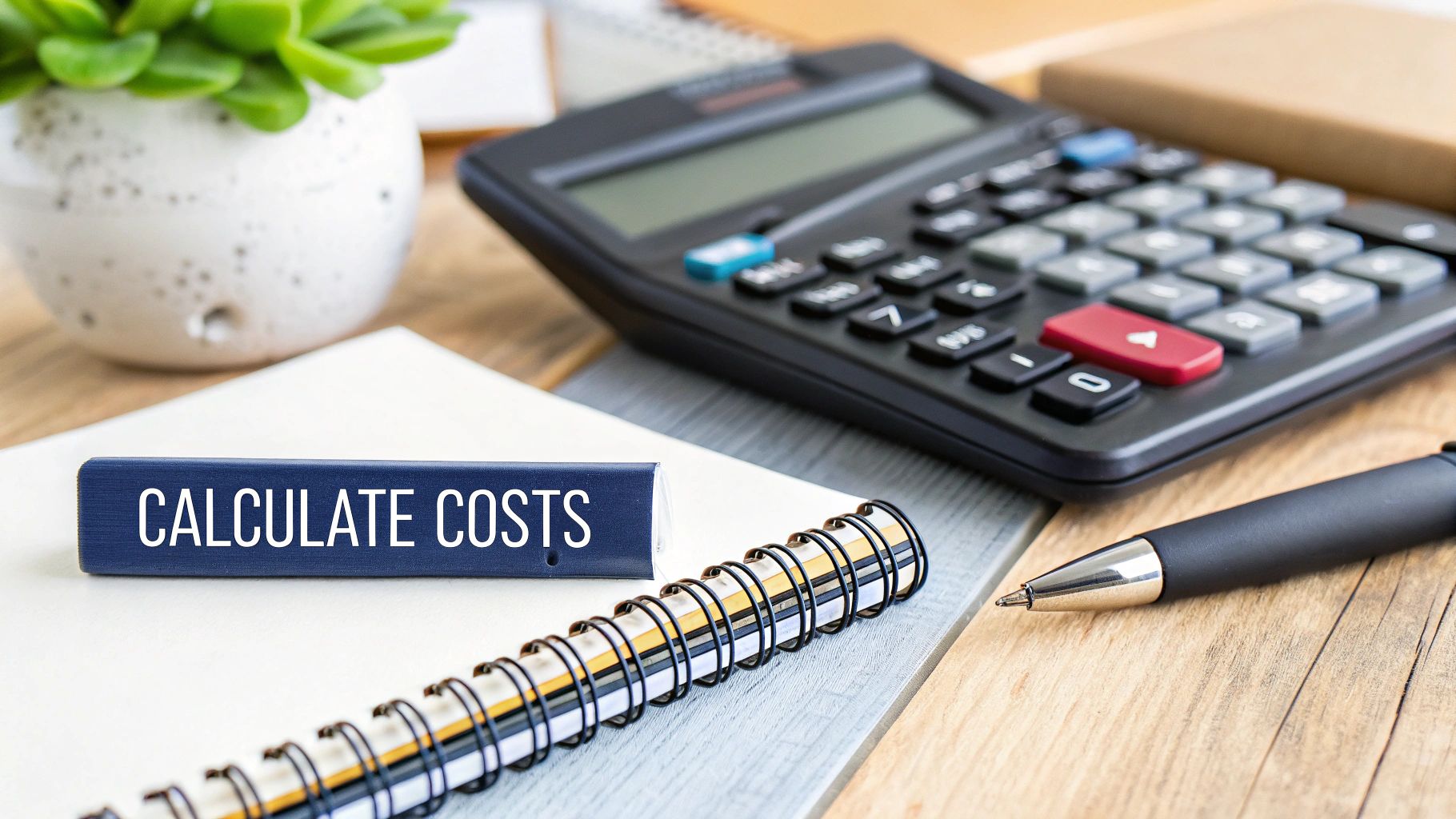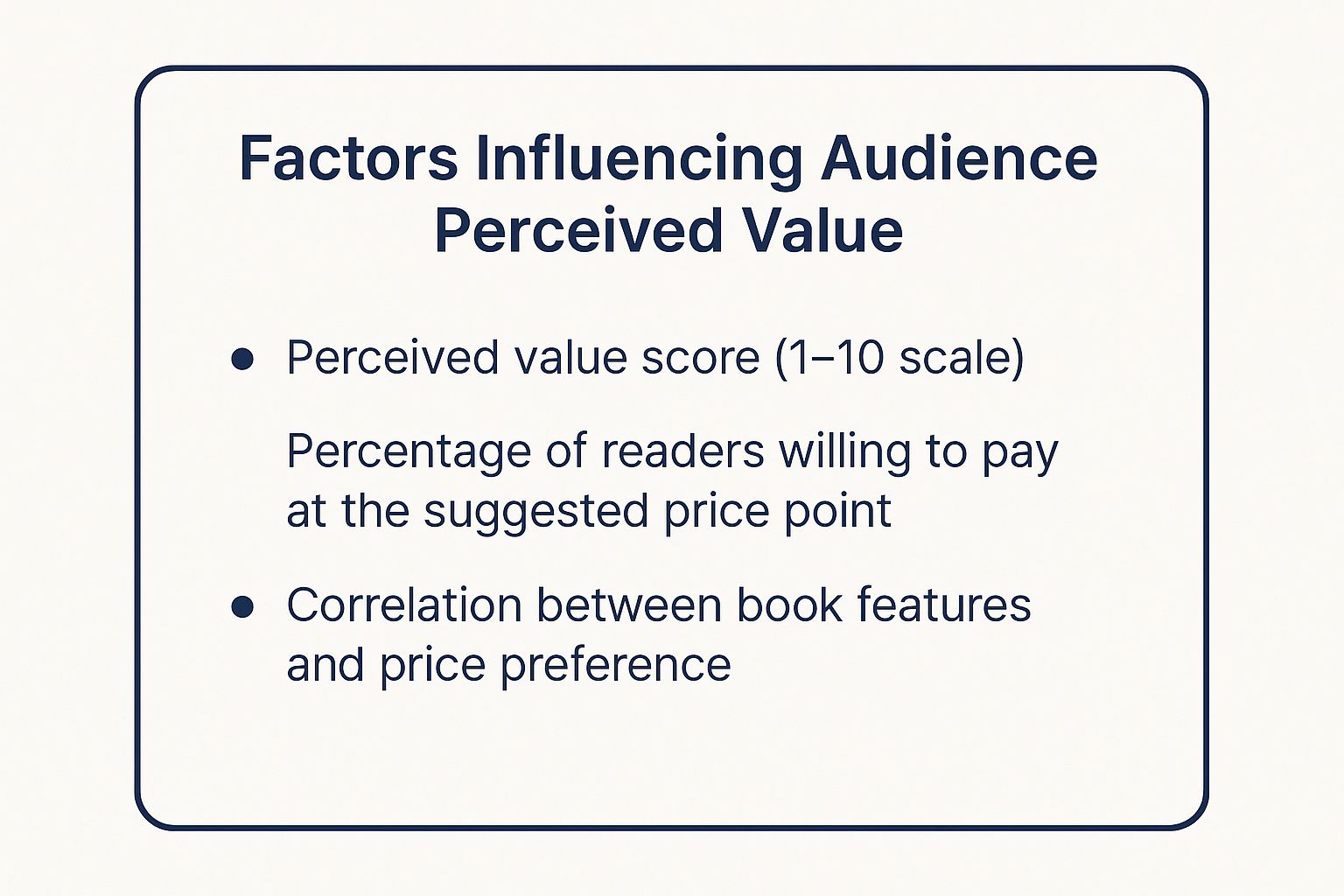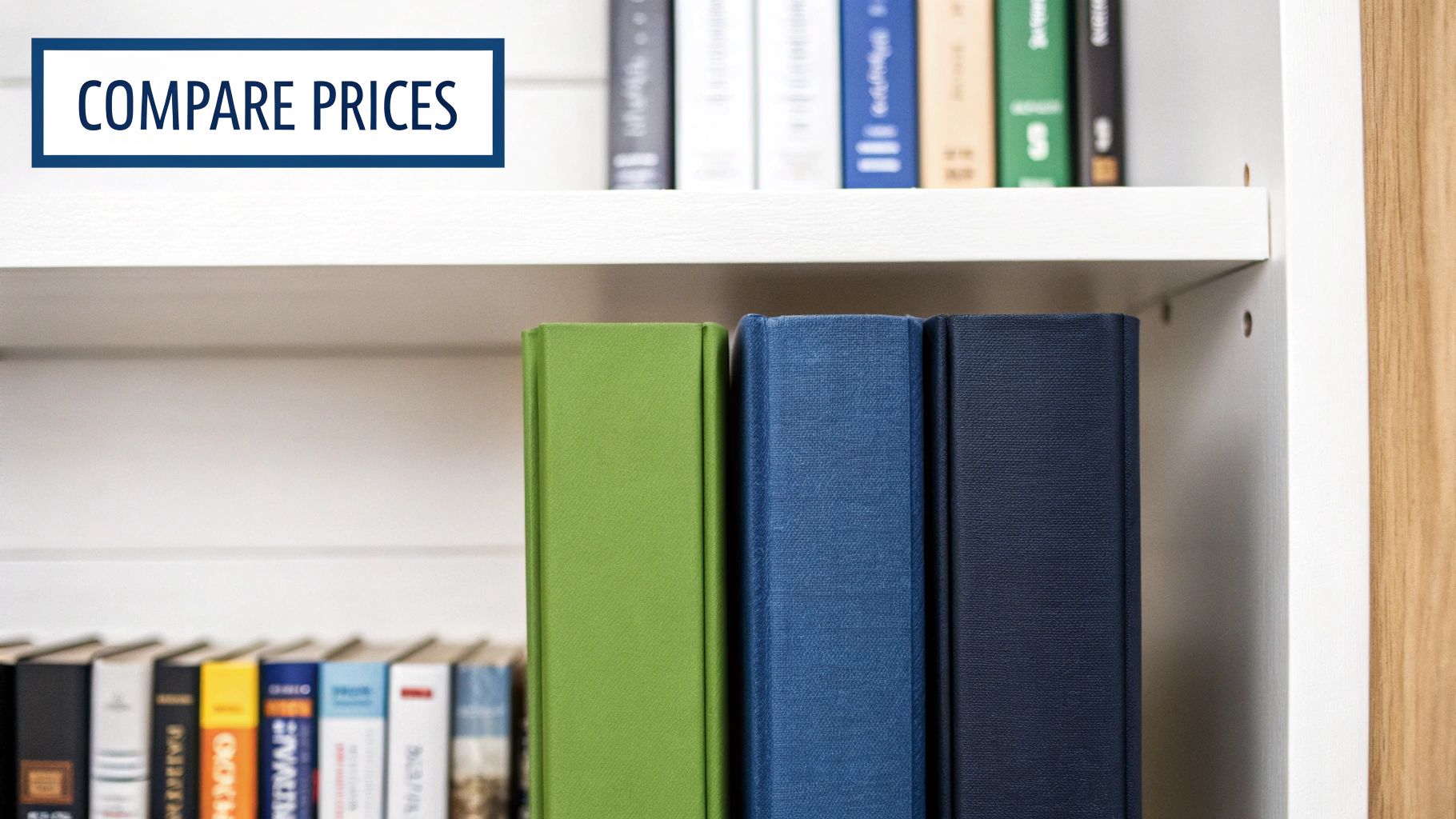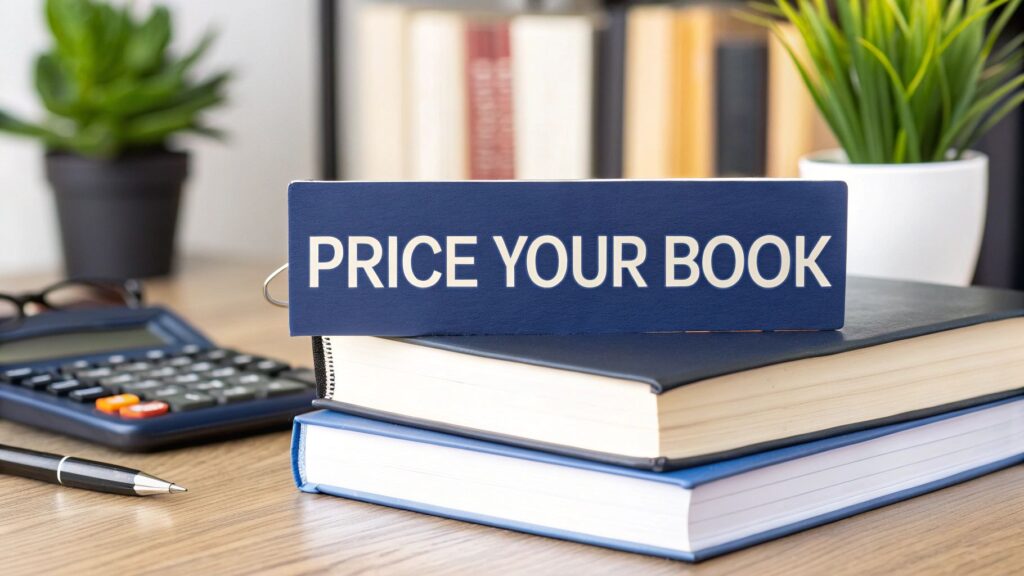Figuring out what to charge for your book can feel like a nail-biting decision, but it doesn't have to be a shot in the dark. The real goal is to land on a price that feels right for your genre, meets reader expectations, and helps you hit your personal author goals. It's all about doing a little homework on similar books to find a strategic price that balances making a profit with getting your story in front of as many people as possible.
Finding Your Book’s Sweet Spot in the Market
Pricing your book isn't about plucking a number from your head—it’s about smart market analysis. As much as it's a work of art, your book is also a product competing for attention. To stand a chance, its price has to make sense to the people you want to reach, convincing them it's worth their hard-earned money over thousands of other options.
Every genre has an invisible "price ceiling" and a "price floor." Readers just have a gut feeling about what a book should cost. An epic fantasy ebook priced at $24.99 would probably feel outrageous to most, while a dense non-fiction guide listed at $0.99 might make readers suspicious about its quality. Your job is to find that sweet spot right in the middle.
Before we get into the nitty-gritty of the numbers, it helps to see the big picture. These are the core factors that will guide your pricing decisions.
Core Factors for Pricing Your Book
| Factor | Influence on Price | Real-World Example |
|---|---|---|
| Genre Expectations | Sets the "normal" price range in a reader's mind. | A contemporary romance ebook is rarely priced like a university textbook. |
| Author Platform | A well-known author can command a higher price than a debut author. | Stephen King's new release can launch at $14.99; a new author might start at $4.99. |
| Book Format | Ebooks, paperbacks, and hardcovers each have their own market price. | A $4.99 ebook might have a corresponding $14.99 paperback. |
| Launch Strategy | Your goals (e.g., visibility vs. profit) dictate your initial price. | Pricing at $0.99 for the first week can drive initial sales and reviews. |
Understanding these elements is the first step. Now, let’s turn this theory into action.
Identify Your Comparable Titles
The most practical thing you can do is find your "comps"—books that are genuinely similar to yours. Think about genre, length, style, and who they’re for. Don't just look at the mega-bestsellers. Pay close attention to the mid-list and indie authors who are targeting the exact same readers you are.
Put yourself in your reader’s shoes: if they just finished a book they adored and yours was recommended next, what price would feel natural to them?
- Genre and Subgenre: Don't just look at "fantasy." If you wrote a flintlock fantasy, look at other flintlock fantasies, not epic high fantasy. The more specific, the better.
- Author's Platform: Are your comps written by household names or first-time authors? New writers often price lower to build an audience from scratch.
- Book Format: Make sure you're comparing apples to apples. Analyze ebook, paperback, and hardcover prices separately, as they function in completely different ways.
By studying these comps, you’re gathering real-world data on what your market will tolerate. And when it comes to finding that market sweet spot, exploring proven strategies for growing an online business can offer some fantastic insights that translate surprisingly well to positioning a book.
Key Takeaway: The point isn't to just copy what someone else is doing. It's to understand the pricing landscape so you can make a strategic choice that works for your book and your goals.
Analyze Pricing Tiers
As you collect a list of 5-10 solid comps, you’ll start to see patterns. Don't just calculate an average price. Instead, look for distinct pricing tiers, which will almost always fall into a few buckets:
- The Low-Tier ($0.99 – $2.99): This is the go-to range for launch promotions, the first book in a series, or for authors laser-focused on gaining visibility fast. It's a volume play.
- The Mid-Tier ($3.99 – $7.99): Here’s the sweet spot for a huge number of indie and traditionally published ebooks. It signals a professionally produced book without the premium price tag.
- The Premium-Tier ($8.99+): You’ll usually see this price point on new releases from A-list authors or for very niche, specialized non-fiction where the reader is paying for expertise.
This analysis is what helps you decide where to position your own book. Do you want to compete on price and draw in the bargain-hunters? Or do you want to project a sense of premium quality from day one? The answer will shape your entire launch.
Tallying Up Your Real Production Costs
Before you can even think about what to charge for your book, you have to get brutally honest about what it cost you to create. This isn't just a casual exercise; it's the foundation of your entire pricing strategy. Without a clear number, you’re essentially flying blind, and that's no way to run an author business.

It’s a classic rookie mistake to overlook the true scope of expenses. Your time writing is valuable, of course, but that’s just the beginning. The real costs are the ones that hit your bank account. Let’s look at the two buckets these expenses fall into.
The Upfront, One-Time Investments
Think of these as the non-negotiable fees you pay to get your book ready for readers. You pay them once, and they don't change whether you sell ten copies or ten thousand. For most indie authors, getting to hand-pick these professionals is one of the biggest perks of self-publishing.
Here’s what you should be budgeting for:
- Professional Editing: This is where you absolutely should not cut corners. It covers everything from big-picture developmental edits to the nitty-gritty of copyediting. Nothing screams "amateur" louder than a book riddled with typos.
- Cover Design: We all do it—we judge books by their covers. A professional, genre-appropriate cover is your best salesperson, especially in a crowded online marketplace.
- Interior Formatting: A clean, professional layout for both your ebook and print versions makes for a seamless reading experience. It’s a subtle but crucial detail.
- ISBN Registration: Some platforms will give you a freebie, but owning your ISBN gives you maximum flexibility and control over your book's distribution.
A word from experience: If you have to choose where to spend your money, pour it into editing and cover design. These two elements single-handedly influence a reader’s decision to buy. A brilliant story can be dead on arrival if it's wrapped in a bad cover and full of errors.
The Ongoing, Per-Copy Costs
Now we get to the variable expenses. These costs are tied directly to each sale or are part of the ongoing machinery of your author business. Getting a handle on these is how you figure out what you actually earn from each sale.
You'll need to account for these recurring costs:
- Printing Costs: For physical books, this is the fee your print-on-demand service (like Amazon KDP or IngramSpark) charges to print and ship a single paperback or hardcover.
- Marketing and Advertising: This is your budget for things like Amazon Ads, Facebook ads, or paying for a spot in a book promotion newsletter. It’s rarely a one-and-done expense.
- Author Platform Maintenance: Think of your author website hosting and your email list provider. These are regular business subscriptions that keep your platform running.
You need to track every single dollar, from the big editing invoice down to your monthly email service fee. To get a better idea of what to expect, take a look at our guide on the full cost to publish a book.
Once you have that final investment total, you can figure out your breakeven point. This is the magic number—the number of books you must sell to earn back every penny you spent. Knowing this empowers you to set a price that not only covers your costs but actually starts generating a profit for all your hard work.
Reading the Market and Understanding Your Reader
Your book isn’t just a story; it’s a product entering a bustling, dynamic marketplace. To price it right, you have to look beyond a few of your direct competitors and really get a feel for the broader economic currents that influence what a reader is willing to spend. It’s about digging into trends, not just in your genre, but across different formats and even countries.

This isn't about a quick glance at today's bestsellers. It's about learning to read the subtle signals the market is sending about reader habits, which will help you position your book for the best possible launch.
The Ebook, Paperback, and Audiobook Trifecta
Modern readers enjoy stories in various ways, and each format comes with its own pricing psychology. You can’t just slap one price on your book and call it a day; your strategy needs to be more nuanced.
- Ebooks: These are often priced to encourage impulse buys, a great strategy for new authors or the first book in a new series. You’ll see price points like $2.99 or $4.99 all over the place because they feel like a low-risk gamble for a reader trying someone new.
- Paperbacks: For a physical book, readers naturally expect to pay more. The price has to cover your print costs and royalties while still feeling like a fair deal. A paperback also adds a certain legitimacy and appeals to those who will always prefer a tangible book.
- Audiobooks: This is a premium experience, and the price tag reflects that. Production costs are significantly higher, and listeners tend to see audiobooks as high-value content. It’s not unusual to see prices at $19.99 or even higher, and this market just keeps growing.
Getting a sense of the big picture is essential. The global book market was valued somewhere between $150 billion and $160 billion in 2022. While print is holding its own, the digital landscape is where you see the most dramatic shifts. Audiobooks have been enjoying double-digit growth nearly every year for a decade, while eBook sales have largely leveled off. This kind of data underscores why a flexible, format-specific pricing strategy is non-negotiable. You can dive deeper into these fiction book sales statistics to see how these trends could shape your own decisions.
Finding the Sweet Spot in Your Genre
Beyond formats, every genre operates like its own little micro-economy. A die-hard thriller reader is probably used to dropping $12.99 on a new release from a big-name author. Meanwhile, a poetry lover might think $18 for a slim, beautifully designed volume is a total bargain.
Pro Tip: Spend a dedicated afternoon on Amazon, Barnes & Noble, and Kobo. Don't just window-shop—investigate. Pull up the top 100 charts for your specific subgenre. Make a note of the ebook and paperback prices from both indie authors and traditional publishers. You'll quickly start to see the accepted price ranges.
Thinking Globally From Day One
Thanks to digital storefronts, your book can land in the hands of readers from Toronto to Tokyo in an instant. But applying a single US-centric price across the globe is a classic rookie mistake. A $4.99 price point that seems perfectly normal in the United States might be a non-starter in a market with different purchasing power.
Most platforms, like Amazon KDP, give you the power to set prices for different territories. Don't just accept the platform's automatic currency conversion and move on. Take a few minutes to research what ebooks are actually selling for in key international markets—think the UK, Germany, Canada, and Australia. Adjusting your price, even just a little, to match local expectations can have a massive impact on your global sales numbers.
Navigating Royalties and Distribution Channels
The price on your book’s cover is just the beginning of the story. The real question is, how much of that sticker price actually makes it into your pocket? The answer to that lies in the sometimes-murky waters of royalties and distribution channels.
Every single place you sell your book, whether it's Amazon KDP or IngramSpark, takes a slice of the pie. And it’s not just a tiny sliver; it's a hefty chunk that directly shapes your profit on every sale. Getting your head around this is an absolute must if you want to set a price that actually pays you for your hard work.
Unpacking Royalty Structures
Royalty rates are anything but standard. They swing wildly depending on the format—eBook, paperback, or hardcover—the list price you set, and the platform you're selling on. Amazon KDP, for instance, has two very different royalty options for eBooks: 35% and 70%.
Want that juicy 70% royalty? You’ll have to price your eBook between $2.99 and $9.99. If you go a penny higher or lower, your royalty automatically plummets to 35%. This is a classic example of how a platform's rules can pretty much make your pricing decision for you.
For print books, it's a whole different ballgame. The math is simple but crucial: your royalty is the list price, minus the platform’s share, and minus the cost to print the book. A sprawling epic fantasy will cost more to print than a slim poetry collection, and that extra cost comes directly out of your earnings.
Key Insight: Stop obsessing over the list price alone. The number you should really care about is your net revenue—what you're left with after everyone else takes their cut. I've seen authors make more money on a lower-priced book with a great royalty rate than on a more expensive book with a terrible one.
As you think about your book, it's worth looking into the different monetization options available to creators on various platforms. It can open your eyes to other ways of earning from your work.
The image below breaks down some of the key factors that influence how readers perceive your book's value and, ultimately, whether they'll click "buy."

As you can see, things like a professional cover and fitting neatly into a popular genre have a direct impact on a reader's willingness to pay what you're asking.
Choosing Your Distribution Channels
How far your book travels depends entirely on your distribution strategy. You can go "wide," which means putting your book on as many storefronts as possible—think Barnes & Noble, Kobo, and Apple Books in addition to Amazon. This certainly expands your potential audience, but it also means juggling different royalty reports, payment schedules, and platform rules. It can be a headache.
The alternative is going exclusive. Enrolling your eBook in KDP Select, for example, gives you access to powerful marketing tools like Kindle Unlimited, but it also means Amazon is the only place your digital book can be sold.
It's also smart to think globally. The global books market is projected to reach an eye-watering $142.96 billion by 2025. While North America is the biggest piece of that pie right now, the Asia Pacific region is growing the fastest. Your pricing needs to be nimble enough to work across different economies and what people are used to paying for books in their country.
Picking the right channels and truly understanding their fee structures are foundational steps. Get this right, and you're well on your way to pricing your book for both maximum profit and reach.
Nailing Down Your Final Price (And Knowing When to Change It)

Alright, you’ve crunched the numbers on your costs, scoped out the competition, and wrapped your head around royalties. Now it’s time for the moment of truth: putting a final price tag on your book. This is where all that groundwork pays off.
Your job is to land on a strategic price for each format—ebook, paperback, and hardcover—that feels right. It needs to honor the investment you've made while also hitting a sweet spot for what your ideal reader is actually willing to pay.
A classic move you’ll see everywhere is psychological pricing. Think $4.99 instead of a flat $5.00. It’s called "charm pricing" for a reason; it subtly frames the cost in a lower dollar range, which can be just enough to nudge an on-the-fence reader into clicking "buy." While it’s a popular trick, especially for ebook impulse buys, don't assume it's a magic bullet for every book or every audience.
The Myth of the "Set It and Forget It" Price
I’ve seen too many authors make the same mistake: they treat their book’s price like it's carved in stone. The truth is, your launch price is just the beginning. The real skill lies in knowing when—and how—to adjust it to keep your sales momentum going for the long haul.
Think of your price as one of the most powerful levers you can pull. A strategic price change can achieve very specific goals at different points in your book's life.
Here are a few moments when a price adjustment makes perfect sense:
- During Launch Week: An aggressive introductory price, like $0.99 or $2.99 for an ebook, can create an initial sales spike. This helps you shoot up the bestseller charts and, just as importantly, start collecting those crucial early reviews.
- For Promotional Campaigns: If you land a spot with a major book promotion service, you'll almost certainly need to slash your price. This is part of the deal, designed to trigger a massive, concentrated burst of downloads.
- When a New Book in a Series Drops: This is a classic tactic. When you release book two, you can make book one temporarily free or drop it to $0.99. It’s a brilliant way to hook a whole new wave of readers and pull them into your series.
Your price isn't just a number; it's a marketing tool. A well-timed price drop can be just as effective as a paid ad campaign, but you need a plan. For more on this, check out our guide on https://barkerbooks.com/how-to-promote-your-book/ to see how pricing fits into a bigger strategy.
Staying Flexible in a Market That Never Sits Still
The book market is anything but static. To keep your pricing sharp, you have to keep an eye on what’s happening. Reader habits change, genres rise and fall in popularity, and new formats emerge. Your pricing needs to be nimble enough to keep up.
Ultimately, your price should be a reflection of both your book's inherent value and the current realities of the marketplace. To get a wider perspective, it can be helpful to look at general pricing strategies from outside the publishing world. By staying informed and refusing to be rigid, you give your book the best possible chance to find its audience and continue earning for years to come.
Frequently Asked Questions About Book Pricing
https://www.youtube.com/embed/pI0NQ8vr0xo
Even with a solid plan, pricing your book can feel like walking a tightrope. A few specific questions always seem to pop up as authors navigate this process. Here are some straightforward answers to the most common pricing dilemmas I see.
Should I Price Books in a Series Differently?
Yes, absolutely. In fact, this is one of the most reliable strategies out there. A proven tactic is to price the first book in your series much lower than the rest—sometimes as low as $0.99 or even making it free for a limited time.
Think of it as a low-risk invitation. You're giving new readers an easy, affordable way to get hooked on your story and characters. Once they’re invested and dying to know what happens next, they'll happily pay the standard price for the rest of the series. Your first book isn't just a story; it's your most powerful marketing tool.
When Is It Smart to Make My Book Free?
Going free should always be a calculated marketing move, not a last resort. It’s a powerful tool, but only when used correctly.
Here are a few scenarios where it makes perfect sense:
- Launching a series: A free first book is the classic way to drive a huge volume of follow-on sales for the rest of your books.
- Gaining quick visibility: When you first launch a book, a limited-time free promotion can create a massive spike in downloads and, more importantly, those crucial early reviews.
- Reviving a backlist title: If an older book's sales have gone cold, a free run can breathe new life into it by introducing it to a whole new audience.
Pro Tip: Avoid leaving a book permanently free unless it’s the cornerstone of a much larger marketing funnel designed to sell other products or services. A free book needs a purpose.
How Often Should I Change My Book Price?
Your pricing needs to be dynamic, but not erratic. Fiddling with your price constantly will only confuse readers and make your book look cheap. The key is to make strategic, planned adjustments.
Consider changing your price during a launch week, for a planned promotion (like a BookBub feature), or right when you release the next book in your series. If sales have completely flatlined, a temporary price drop can also be a great diagnostic tool—it tells you a lot about how readers perceive your book's value. Always analyze your sales data after a promotion; it’s essential for refining your long-term strategy. You can find some great book promotion ideas to pair with these price drops.
Should My International Prices Be Different?
Without a doubt. Just letting a platform auto-convert your US price into other currencies is a huge missed opportunity. You should be setting custom prices for major international markets yourself.
Look at factors like local purchasing power, what readers in that country expect to pay for your genre, and what your competitors are charging there. For instance, ebooks are often priced significantly lower in some European markets compared to the US. Nearly all distribution platforms give you the controls to set territory-specific pricing—take the time to use them. It’s worth it.
At BarkerBooks, we guide authors through every step of the publishing journey, from professional editing and captivating cover design to global distribution and targeted marketing. Transform your manuscript into a professionally published book and reach readers worldwide. Learn more about our author services and start your journey today.
